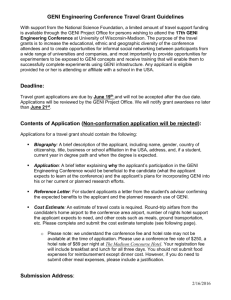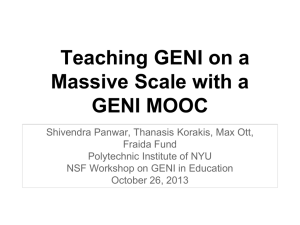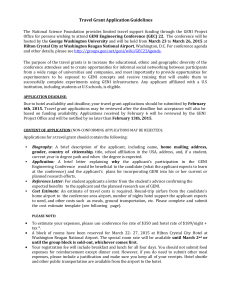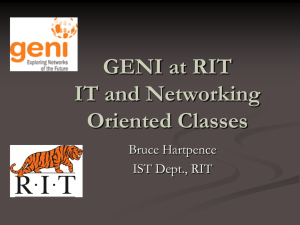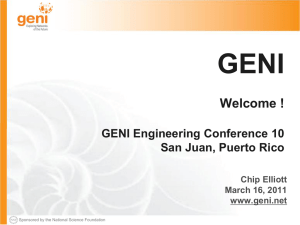VINI: Virtual Network Infrastructure
advertisement
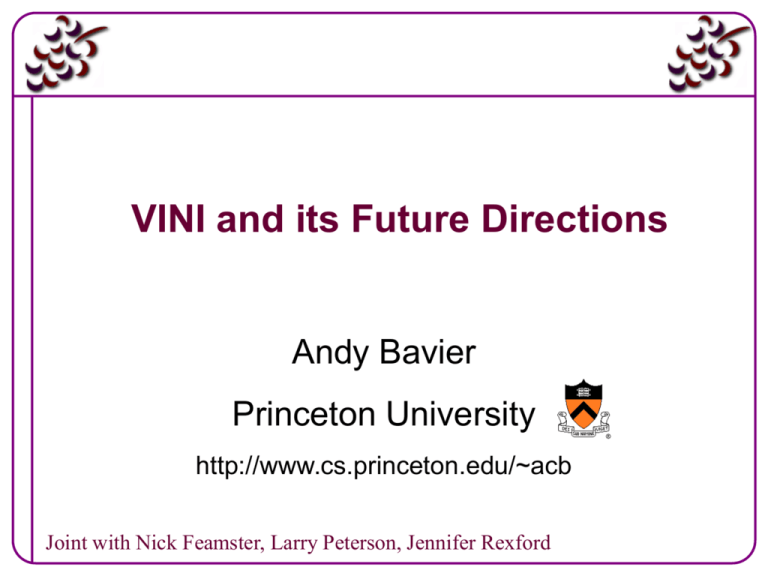
VINI and its Future Directions Andy Bavier Princeton University http://www.cs.princeton.edu/~acb Joint with Nick Feamster, Larry Peterson, Jennifer Rexford 1 Technology Transfer SIGCOMM paper Deployment studies Commercial adoption • Deploy and support a prototype system – Wide area, longer timescales, real traffic, etc. • Technical feasibility – Scalability, robustness under realistic conditions – System integration and testing • Economic incentives – Real users potential market 2 Overview • VINI vision –Enable deployment studies in real networks –Share the nodes, links using virtualization • Current status of VINI • Future directions for VINI • VINI and the NSF GENI project 3 Fixed Infrastructure VINI nodes in National LambdaRail, Internet2, PoPs in Seattle and Virginia, CESNET Shared Infrastructure Experiments given illusion of dedicated hardware Flexible Topology VINI supports arbitrary virtual topologies Network Events VINI exposes, can inject network failures External Connectivity c s Experiments can carry traffic for real end-users External Routing Adjacencies BGP BGP c s BGP BGP Experiments can participate in Internet routing Overview • VINI vision –Enable deployment studies in real networks –Share the nodes, links using virtualization • Current status of VINI • Future directions for VINI • VINI and the NSF GENI project 10 VINI Current Status - Deployment • Two VINI nodes per site • Operational sites: –7 NLR sites –9 Internet2 (NewNet) sites –2 colo sites: Seattle WA, Ashburn VA –1 European site: CESNET Prague • 1Gb/s lightpath between Prague and VINI Internet2 nodes in Chicago 11 VINI Status - Virtual Hosts • VINI based on PlanetLab software –Simultaneous experiments in separate VMs –Each has “root” in its own VM, can customize –Reserve CPU and bandwidth per experiment Node Mgr Local Admin VM1 VM2 … VMn Virtual Machine Monitor (VMM) (Linux++) PlanetLab node 12 VINI Status - Virtual Networks • Configure a virtual topology for a slice –Point-to-point virtual Ethernet links –Slice controls routing table, virtual devices on the virtual hosts • Purpose: allow experimentation with routing software (e.g., XORP, Quagga) that already runs on Linux VINI Trellis v0.1 application user kernel kernel FIB virtual NIC virtual NIC bridge bridge shaper shaper EGRE tunnel EGRE tunnel Virtual host • Linux kernel IPv4 routing table • Point-to-point virtual Ethernet • Applications add/change routes Substrate • Ethernet software bridge • Traffic shaper • Ethernet-over-GRE tunnels (to span multiple IP hops) Overview • VINI vision –Enable deployment studies in real networks –Share the nodes, links using virtualization • Current status of VINI • Future directions for VINI • VINI and the NSF GENI project 15 Future Questions for VINI • How to leverage other testbeds? – Experiments, user communities, tools, etc. • How to grow VINI? • What new features should VINI offer? – Custom hardware – Programmable data planes • How to link a virtual network to the “real world”? – Real users, real traffic, real routing information Leveraging Other Testbeds • Testbed federation mechanisms –Federate VINI with PlanetLab, Emulab, OneLab –Create experiments that span multiple testbeds –Move experiments from one testbed to another • Open, modular system architecture –Incorporate Emulab topology creation GUI Deploying more VINI nodes • You can join the public VINI –CESNET deployment: Prague, Pilsen, ??? –Other European research networks? • You can create your own VINI –VINI is a “private PlanetLab”, based on MyPLC –MyVINI = MyPLC + VINI kernel, tools –Development platform or dedicated testbed Adding New Features • VINI technology trade-offs: – Performance (to carry real traffic) – Isolation (to support multiple experiments) – Programmability (make it easy to use) • Custom hardware – NetFPGA from Stanford – Supercharged PlanetLab Platform from WUSTL • Programmable data plane – Allow users to run Click Modular Software Router in Linux kernel, on NetFPGA Connecting to the World • Getting real routing information –BGP Multiplexer service –Receive BGP information from real routers –Advertise routes, experiment becomes ISP • Getting real traffic –Deploy wireless access points –Hide behind a proxy (e.g., game server) –Leverage existing PlanetLab services (e.g., CDN) 20 Overview • VINI vision –Enable deployment studies in real networks –Share the nodes, links using virtualization • Current status of VINI • Future directions for VINI • VINI and the NSF GENI project 21 NSF’s GENI Vision A national facility to explore radical designs for a future global networking infrastructure • Large, wide-area footprint • Enables large-scale, end-to-end experiments • Shared among researchers by virtualization & slices Current / projected substrates High capacity optical nets and programmable cores Large clusters of CPUs, storage Edge / access technologies (e.g. cellular, sensor networks) How GENI will be used • GENI is meant to enable . . . – Trials of new architectures, which may or may not be compatible with today’s Internet – Long-running, realistic experiments with enough instrumentation to provide real insights and data – ‘Opt in’ for real users into long-running experiments – Large-scale growth for successful experiments, so good ideas can be shaken down at scale • A reminder . . . – GENI itself is not an experiment ! – GENI is a stable facility on which experiments run GENI creates a huge opportunity for ambitious research! Spiral Development GENI grows through a well-structured, adaptive process • An achievable starting point Planning Design Example: Rev 1 “narrow waist”, federation of multiple substrates (clusters, wireless, regional / national optical net with early GENI ‘routers’, perhaps some existing testbeds), Rev 1 user interface and instrumentation. • Envisioned ultimate goal Use Use Example: Planning Group’s desired GENI facility, probably trimmed some ways and expanded others. Incorporates large-scale distributed computing resources, high-speed backbone nodes, nationwide optical networks, wireless & sensor nets, etc. • Spiral Development Process Integration Build out Strawman GENI Construction Plan Re-evaluate goals and technologies yearly by a systematic process, decide what to prototype and build next. Federation GENI grows by “gluing together” heterogeneous facilities over time My experiment runs across the evolving GENI federation. Wireless #1 Corporate GENI facilities Backbone #1 Compute Cluster #1 Compute Cluster #2 My GENI Slice Access #1 Backbone #2 NSF parts of GENI Other-Nation GENI facilities Other-Nation GENI facilities This approach looks remarkably familiar . . . Wireless #2 Goals: avoid technology “lock in,” add new technologies as they mature, and potentially grow quickly by incorporating existing facilities into the overall “GENI ecosystem” VINI and the GENI Project • VINI and PlanetLab can be regarded as small-scale prototypes of pieces of GENI • Goal: Be GENI-compliant –Participate in GENI design efforts –Implement new GENI interfaces –Influence GENI development process • First GENI solicitation: Feb 2008 26 Conclusion • VINI is a platform for deployment studies • Need help growing, developing VINI –Install VINI nodes in national research networks –Extend the VINI platform (e.g., federation) –Perform interesting research on VINI • Goal: influence the GENI effort in the US http://www.vini-veritas.net



